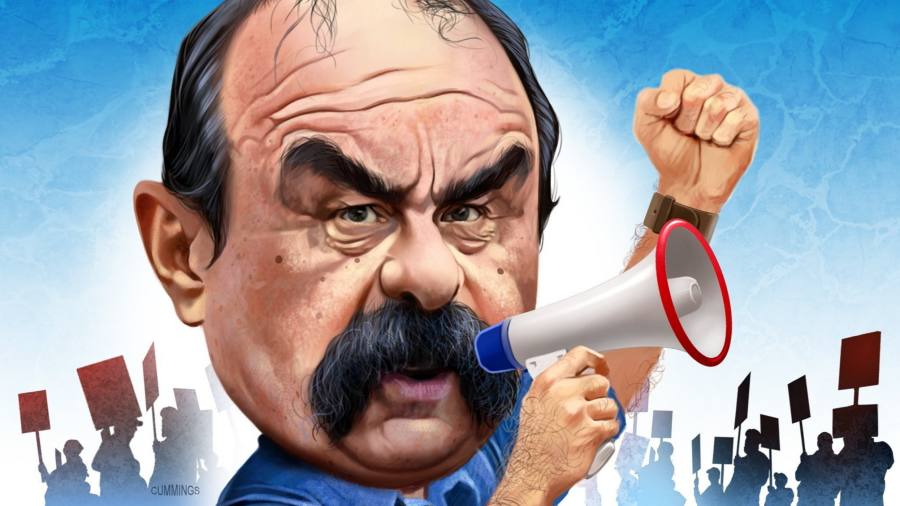Philippe Martinez, the union leader taking on Macron

With his bushy moustache and gruff manner, Philippe Martinez certainly looks the part of the revolutionary Frenchman as he leads protests aimed at forcing President Emmanuel Macron to abandon his bid to raise the retirement age.
But people who know him say the 61-year old boss of the CGT, France’s oldest and most hardline labour union, has carefully cultivated that image, which is in fact somewhat artificial. The real Martinez, they say, is a canny negotiator and pragmatist with a dry sense of humour.
The former metalworker at automaker Renault is now putting those skills, as well as his notoriety, to use in the most pivotal battle of his eight-year tenure at the helm of CGT.
Blocking Macron’s pensions reform is the immediate priority. But so is managing his succession (he steps down at the end of the month) and keeping the CGT relevant at a time when membership has fallen so much that it has lost its crown as France’s biggest union to the moderate CFDT.
“We must put France at a standstill to make the president hear us,” said Martinez on Monday. The CGT has hardened its tactics, with rolling strikes that have disrupted transport, blocked deliveries to petrol stations and cut electricity output at nuclear plants.
Martinez has been preparing for this moment since childhood. He was born in a Paris suburb to a Spanish republican activist mother. His father, a Frenchman, fought with anti-Franco forces in the Spanish civil war.
“Philippe grew up in a militant family so has been going to protests since he was a kid,” says Fabien Gâche, a former colleague at Renault. “The conviction that social progress can come only from workers establishing their power in the streets is something that is deep in his DNA.”
He first joined the Communist party’s youth wing in high school, but later left the party. At 21, he began working as a technician at the Renault factory in Boulogne-Billancourt on the outskirts of Paris. He remained at the French carmaker for his entire career.
At Renault, he joined and climbed the ranks of the CGT, which was founded in 1895 and has long been associated with international socialism and the Communist party. Dominique Andolfatto, a political scientist at the University of Burgundy, says that although the CGT was often seen as monolithic, it always contained diverse leftwing currents. “It is a union that is a reflection of French national history and symbolises the fragmentation of the left.”
By the 1970s, the CGT had 2mn members. But by the time Martinez was fighting for workers at Renault, the union was already on the wane. Globalisation led to a wave of factory shutdowns in France, while unions struggled to shield workers from the effects of more intense competition and deregulation in business. Membership has fallen to about 660,000 today, according to Andolfatto.
Martinez was not to solely to blame for the decline, according to Denis Gravouil, the head of the CGT branch representing workers in the cultural sector. He notes the frequent trips to companies of all sizes and types to hear from workers. “Everyone wanted to take selfies with him in the factories and at protest marches,” Gravouil says. “But he is not very diplomatic, so that has created tensions internally.”
Since the pensions protests started, the CGT has formed a successful coalition with seven other unions in what has turned out to be the biggest such mobilisation in decades. Martinez has allowed his critics to demonise him and the CGT for intransigence, letting the CFDT’s Laurent Berger be the face of the movement. In a front-page photo of the pair beaming at each other at a protest, the newspaper Libération dubbed the bromance “La lutte de miel”, which is a play on the French words for honeymoon and class warfare.
“Philippe Martinez is not some awful person as some would like to paint him,” said Berger in an interview. “He is a unionist who has carefully cultivated his image as a curmudgeon but actually he is totally focused on labour issues. He has led this movement in a very responsible manner.”
Martinez is adamant that raising the retirement age to 64, which is paired in Macron’s proposed reforms with the requirement to work 43 years for a full pension, is profoundly unjust — he argues that it hurts blue-collar workers the most. The CGT wants people to retire at 60 with higher pensions for all, and he would fund it with higher taxes on companies and the rich.
A government official who knows Martinez audibly sighs when asked about the CGT’s pensions plan. “It would wipe out millions of jobs!” the person says. “Philippe is so dogmatic. His positions are out of date.”
Within the CGT, Martinez is actually seen as a moderate who has sought to attract younger members by adding issues such as climate change and feminism to the union’s agenda. He has nominated Marie Buisson, a schoolteacher, to succeed him, although other candidates are also running. She would be the first woman to lead the CGT, and the only one at the head of any of the major unions today.
Asked by a TV journalist recently whether he would shave off his moustache once he retired since he no longer needed to “inspire fear”, Martinez shot back: “You don’t like my moustache?” Regardless of the fate of his facial hair, he vowed that he would “still be in the streets with my comrades although no longer at the front of the marches”.
This article has been amended to clarify that Marie Buisson will be the first woman to lead the CGT; other major unions have been led by a woman
Share this news on your Fb,Twitter and Whatsapp
Times News Express:Latest News Headlines
Times News Express||Health||New York||USA News||Technology||World News